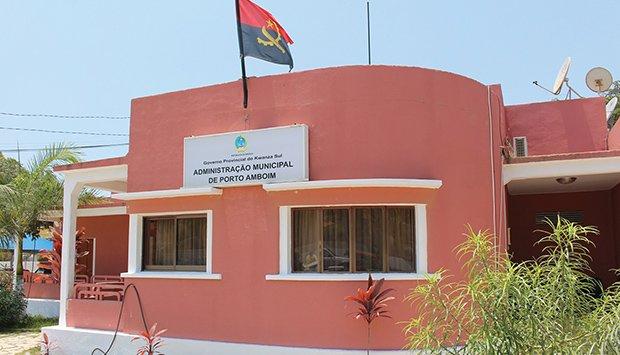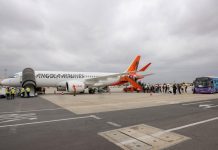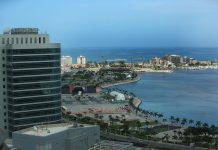Africa-Press – Angola. The city of Porto Amboim, formerly Benguela Velha, seat of the municipality with the same name, in the province of Cuanza-Sul, marked, yesterday, 435 years since its elevation to the category of city, with enormous challenges to overcome the conjunctural difficulties and walk with sure steps towards development in the various domains of socio-economic life.
Porto Amboim has existed since 1587, during the Portuguese colonial system. With the achievement of National Independence, the city has always been at the center of the Angolan Government’s attention, as it is the hub that connects the capital to the south of the country.
Its foundation took place on October 15, 1587, by Paulo Dias de Novais, a Portuguese navigator. It is inhabited by the Mupinda peoples, originally from the North of Angola, through the kingdom of Ndongo.
From a historical point of view, the city of Porto Amboim was also a point of clandestine slave trade. In 1867, at the initiative of four Portuguese settlers, cotton cultivation began in the region, which during the colonial system had a significant weight in the economic balance of the then overseas province.
Since then, the city has undergone transformations, the result of various projects and programs of the central and provincial government. The objective is to make Porto Amboim appear on the list of cities with habitable conditions and worthy of living.
The administrative authorities consider that the implementation of the development process requires public and private sector investments, since the municipality has enormous potential and is capable of growth.
Its potential, in terms of fishing resources and other initiatives linked to the metalworking industry, implemented in the region, make the city of Porto Amboim one of the industrial centers of the province.
This conviction is justified by the fact that metalworking industries are located there, such as the Heerema Group and Paenal, the last owner of one of the largest cranes on the African continent, with a capacity to support 2,500 tons.
Other social enterprises that enhance the city of Porto Amboim are the mineral water industries, the Oceanic Terminal of Sonangol Logística, which supplies fuel and butane gas for various purposes.
Agri-livestock and fishing potential
The administrator of the municipality, Maria Domingos Sumano, told that, after 20 years of effective peace in Angola, the provincial government continues to work, through programs and projects, so that the city of Porto Amboim can rescue its agricultural, livestock, fishing and industrial potential, at the provincial, national and regional levels.
When taking stock of the 435 years, Maria Sumano stated that the city is experiencing problems similar to those of other cities on the coast, especially with regard to sanitation, which in rainy seasons constitutes a “battle horse”.
The municipal administrator added that another problem that the city is experiencing has to do with the poor distribution of drinking water to citizens, due to the state of degradation of the local ETA (Water Treatment Station), which she considered obsolete. “We are experiencing a critical period in terms of water supply, not because the reservoirs are lacking, but because of the low capacity, given the exodus of the population,” she said.
In the same way, the supply of water to the communities is also made with immense difficulty, especially in the communities of Choba, Kilómetro 28 and Denda.
Maria Sumano acknowledged the levels of development that the city of Porto Amboim and the municipality in general have been reaching, but stressed that the arduous battle ahead that will provide the resolution of the numerous problems that still afflict the populations.
“Every year we notice that our city and the municipality in general are progressing in the most varied areas, but we still don’t feel our duty fulfilled, taking into account the range of tasks that we have to develop to solve the problems of our populations”, admitted the municipal administrator.
Ongoing projects
The municipal administrator of Porto Amboim said that important projects were being carried out, within the framework of the Integrated Plan for Intervention in Municipalities (PIIM), with emphasis on the project to asphalt 20 kilometers of the urban center of the city, completion of the works of two schools of seven classrooms each, while one has already been completed.
Other actions being carried out, within the framework of the Local Development and Combating Poverty Program, focus on the requalification of access roads, expansion of the drinking water supply network, in the city and surroundings, as well as public lighting in the urban center and neighbourhoods.
The repair of access roads that connect the production areas to the city, as well as the promotion of initiatives that leverage the Fisheries sector, the Salt Industry, the promotion of the Agriculture and Livestock sector and entrepreneurship for populations, especially young people, are , according to Maria Sumano, other projects designed by the municipal administration.
Challenges
Of the challenges for the coming times, the municipal administrator of Porto Amboim announced the advocacy with the competent bodies for the construction of an ETA with great capacity and the respective conduct, to serve the citizens. Reference was also made to the continuation of the process of improving basic sanitation, as well as the implementation of projects aimed at the inclusion of women in rural areas.
The other bet for the near future, according to Maria Sumano, is to promote training in arts and crafts to ensure employability among young people, support for family farming and others.
Among the main concerns in the municipality, the administrator pointed out unemployment among young people. “We have in the city of Porto Amboim companies in the metal-mechanic sector, such as Paenal, Heerema Group and many others that employed many young people. With the financial crisis and other problems resulting from the Covid-19 pandemic, they had to lay off a lot of people. , a situation that worries us, since unemployment generates criminality”, said Maria Sumano, visibly sad.
Health and Education Needs
The Health and Education sectors in the municipality of Porto-Amboim are also experiencing the country’s cyclical difficulties. Indeed, in order to provide those services to the populations, the local authorities redouble their efforts in order to respond to the demand.
The health network of the municipality of Porto Amboim has 23 health units, including a municipal hospital with 95 beds for inpatient treatment, medical centers and health posts. According to the health authorities, the inhabitants of the municipality are frequently faced with cases of malaria, acute respiratory and diarrheal diseases, among others.
The Education sector comprises a school network with 44 schools, one of which is private. The current academic year is attended by 36,711 students from the various teaching subsystems, and with a teaching staff made up of 961 teachers.
Despite the registered growth indicators, the municipality of Porto Amboim still has shortages in school infrastructure and teachers to meet demand. According to the administrator of the municipality, Porto Amboim needs another 415 teachers and 77 classrooms to cover the needs of the teaching and learning process.
Agriculture and Livestock
The Agriculture and Livestock sector is what most concerns the authorities of the municipality of Porto Amboim and the province in general. There are irregularities in the rains, so pasture is also becoming scarce in many places in the municipality.
Authorities admit that the situation is taking on alarming proportions, causing livestock to die due to lack of water and pasture. As an alternative, ranchers are moving livestock to the banks of the Longa and Keve rivers, whose transhumance has entailed numerous costs.
The animal population in Porto Amboim comprises 32,000 head of cattle, 22,000 of goats and 3,000 of sheep.
The Fisheries sector has been one of the sectors that employs the population and generates income, but the lack of support in equipment is hampering the fishing activity on a large scale. Among the most salient difficulties is the lack of a shipyard to support the sector.
Appeal to natives in the diaspora
The municipal administrator regretted that many Angolans from Porto Amboim and who are in the diaspora have forgotten the land where they were born.
“We need more solidarity and we appeal to all those who see themselves in Porto Amboim to join the efforts for its reconstruction, because we must not orphan the land that saw us born”, he exhorted.
Maria Sumano said that the municipality needs more investments and asked businessmen to develop projects that meet the needs of the population. In fact, she reiterated the administration’s full support for business initiatives that may arise in the region.
Among the sectors that most need urgent intervention, the administrator pointed out the tourist areas of Buambua, Yaia, Cuvo and the Longa Tourist Complex.
Maria Sumano also defended the expansion of the hotel network in the municipality.
The municipality of Porto Amboim covers an area of 3,311 square kilometers and has 118,564 inhabitants, who mostly live from fishing, cattle raising and agriculture.
Administratively, the municipality of Porto Amboim is divided into two communes: the headquarters and Capolo.
For More News And Analysis About Angola Follow Africa-Press






